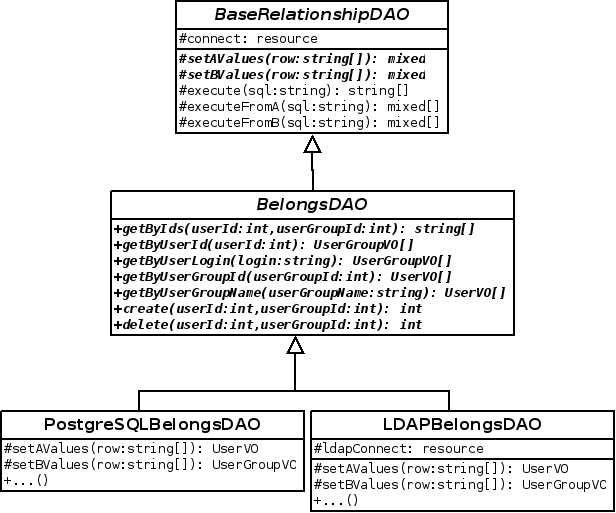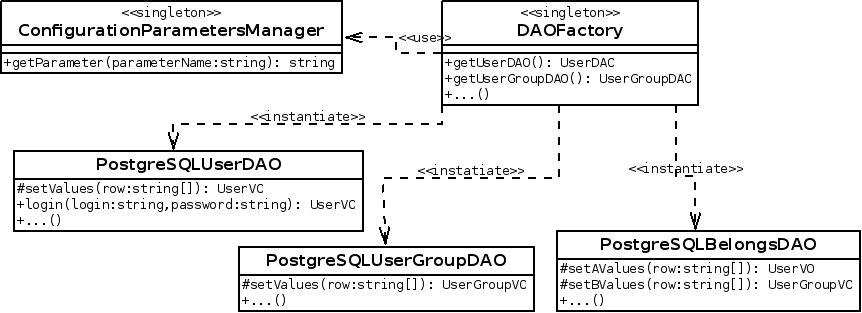Data access layer
Purpose and design
The data access layer is in charge of the transformation between the data stored in persistence and the objects that are treated by the application. In its design we have used the patterns Data Access Object (DAO) and Value Object (VO), in addition to Singleton, Template Method and Abstract Factory.
DAO design
The following two figures show the structure of three DAOs and the classes related with them. They are the model for any DAOs in the system; there are two hierarchies of DAOs: those that extend BaseDAO, which define the operations on tables that represent entities, and those that extend BaseRelationshipDAO, which define the operations on tables that represent relations.


In both hierarchies there are three levels of inheritance:
- The first level contains the parent classes for all the DAOs of a certain type.
- In the second level is composed by abstract classes, one per table in the DB, that define the operations on that table.
- In the third level there are implementation details for specific different DB management systems.
Starting by the first level of inheritance, see that the class BaseDAO defines two template methods, setValues and execute, whereas the class BaseRelationshipDAO defines some more: setAValues, setBValues, executeFromA and executeFromB. They are used to be able to implement some DB operations in a generic way, leaving the specific parts of the DB manager isolated inside these functions, which will be implemented in a lower level of the hierarchy.
The classes in the second level of inheritance group the operations on each table of the DB. There is one class per table, and contains quite a lot of methods; some implement CRUD operations (create, update and delete), others run queries on the table in function of diverse parameters, and others are entity-specific operations, like login for the entity User or add and delete users from a group in UserGroup.
In the third level of inheritance, template methods for DB-specific operations are implemented, in addition to those methods that have some dependency on the DB management system. For example, the operation login uses an encryption function specific to PostgreSQL, therefore it is implemented in PostreSQLUserDAO.
VO design
Value Objects, from now on VOs, are object representations of tuples in the DB. There is a VO class for every table that contains all its attributes, together with getter/setter methods to manipulate them. These objects are usually instantiated in the DAO as a result of a query, although they also can be instantiated in upper layers with the purpose of running a DAO creation operation.

The figure above shows all the VOs of the application. Most of them are implemented only with one class, although there are some special cases. On the one hand, we have the BaseHistoryVO hierarchy, an abstract class grouping a set of attributes, together with their access methods, that are common to several VOs. On the other hand, we have the CustomProjectVO class, which extends ProjectVO with a set of additional attributes. These attributes do not directly correspond with any data of the DB, but they are calculated in base to one or several of the basic attributes of projects and related entities. The calculations are done when the CustomProjectVO is instantiated in the corresponding operation of the projects DAO, and their results are destroyed when the custom object is destroyed; they are never stored in the persistence layer. The additional attributes in the custom object are interesting for several project data visualisation screens, and is a good idea to implement the algorithm for their calculation in one point of the application model layer.
DAO factory
To ensure the independence between the specific implementation of DAOs and the upper layers of the application, DAOs are instantiated through the DAOFactory singleton class. This class has methods to get instances of any DAO, and is albe to select the suitable implementation of each DAO in run time from the content of application configuration file. To access the configuration file it uses the class ConfigurationParametersManager.
The figure below illustrates the design of this class and its main relations:

DAO implementation configuration
There are two ways to configure the specific implementation of DAOs. In the application configuration file, there is a parameter to define the implementation to be used as a general case, while there is an individual parameter for every DAO that allows to replace its specific implementation independently from the rest of them. The DAOFactory object is the one that manages this logic, according to the next sequence diagram:

This feature supports the implementation of LDAP authentication support and can be used to implement certain scenarios of integration with external services, for example, integrate an external calendar service to supply work calendars.